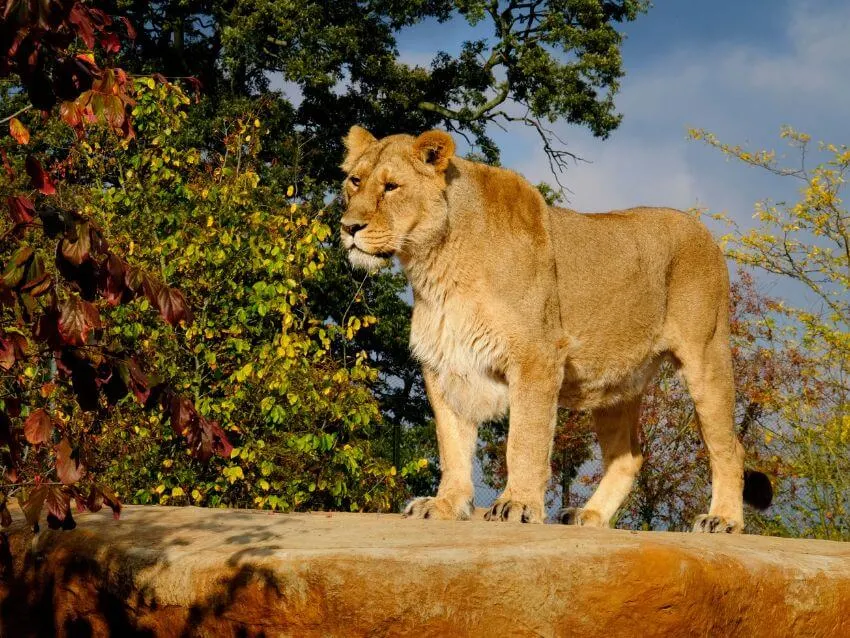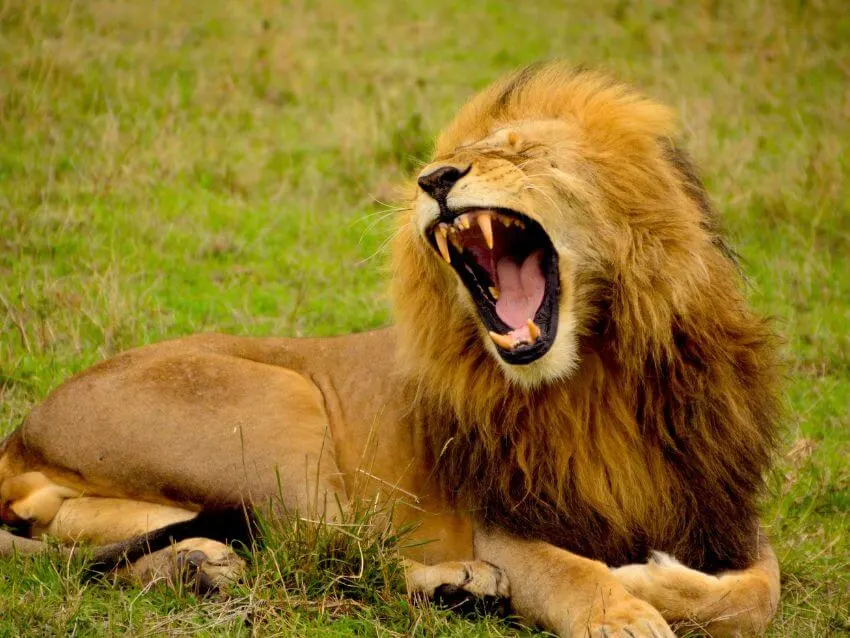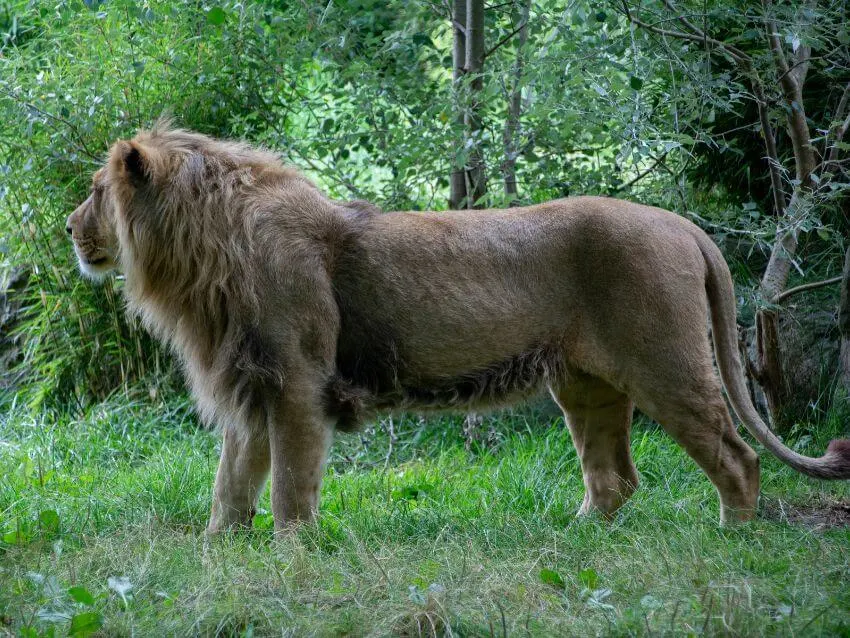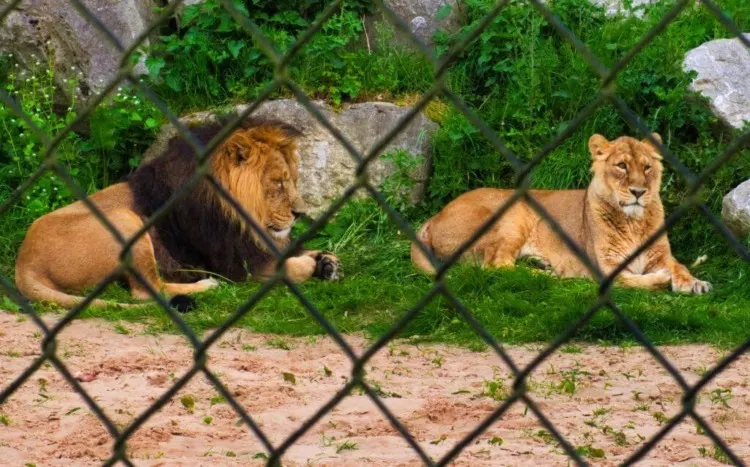The Asiatic lion is a subspecies of the African lion. Although the name “lion” comes from Africa, there are numerous Asian lions that are virtually identical to their African relatives. In China, India, and Kazakhstan, Asian lions exist that are smaller in size and have a lighter coloration than their African counterparts.
The Chinese lion variety, unlike other types of mountain lions, has not been hunted to extinction. It is an important conservation target, particularly for captive breeding efforts. These lions will never be able to survive on their own!
- Status: Endangered
- Known as: Asian Lion, Asiatic Lion, or Indian Lion.
- Estimated numbers left in the wild: 411.
Description of Asian Lion

The Asian lion is a large predatory cat and a type of lion, very similar to the African lion in physical size and appearance, though they are somewhat smaller. The longest recorded Asian lion was 2.92 meters long; most stand around a meter high at the shoulders and weigh 110 to 120 kilograms for females and 160 to 190 kilograms for males.
These species also differ in having a long fold of skin running along their underside, including their chests and stomachs. The male Asian lion has a mane, but it is not as full as the African lion’s mane.
Pride structure
Asian lions live in pride, similar to those of the African lion, but these are smaller and include only two to five females each.
This is due to the fact that they prey on much smaller animals than their African counterparts, and therefore do not need large numbers to kill their prey cooperatively.
Hunting

Deer, antelope, and boar form most of the Asian lion’s diet, all of which need less force to bring down and thus support a more diffuse population. The chital – a 50-kilogram spotted deer – makes up the majority of its kills at 45% of the total. A single lion can easily overpower a chital, lessening the need for pride cooperation further.
Asian lions take domestic animals as well as wild ones, with several thousand kills occurring annually near the wildlife refuge.
The number of kills has declined since livestock was successfully shifted out of the Gir Forest but remains problematic since it provides an incentive for poaching, trapping, and other harmful activities. Fortunately, resettlement and the removal of domestic animals have caused a dramatic population rebound in the Asian lions’ natural prey.
Location of Asian Lion

The Asian lion is found only in India’s Gujarat Province today, predominantly in the Gir Forest National Park and Wildlife Sanctuary.
Three protected areas (Gir Sanctuary, Gir National Park, and Pania Sanctuary) represent the core habitat of the Asian Lion with an area of 1452 km2 of forest. Two further sanctuaries ( Mitiyala and Girnar) provide protection for dispersal or satellite areas.
A new sanctuary, in the Barda forest, is being established in order to provide alternative habitats for Gir lions.
These protected areas consist of dry teak forests, deciduous forests, thorny forests, and savanna with diverse flora and fauna. Check these other types of terrain out there.
Asian Lion size

The confirmed record length of a male Asiatic lion is 2.92 m (115 in), including the tail. Emperor Jahangir is said to have slain an enormous lion in the 1620s that measured 3.10 m (122 in) and weighed 306 kg (675 lb).
In 1841, English explorer Austen Henry Layard went on a hunting expedition in Iran and saw a lion that “had caused much damage in the plain of Ram Hormuz,” after which one of his companions shot it.
In 1933, a lion was allegedly encountered in India as “large as a calf but very dark brown in color,” with some regions of its body being almost black. In 1935, a British admiral claimed to have seen a maneless lion feeding on a goat near Quetta in Pakistan.
Asian Lion habitat
The Gir Forest, located in the Gir and Girnar hills systems of Gujarat’s largest tracts of tropical and subtropical dry broadleaf forests, thorny forest, savanna, and important habitat for a rich flora and fauna, is home to several wild animals including lions.
There are currently five protected areas in India that seek to protect the Asiatic lion: Gir Sanctuary, Gir National Park, Pania Sanctuary, Mitiyala Sanctuary, and Girnar Sanctuary. The Gir Conservation Area is a 1,452 km2 (561 sq mi) large forest block that contains the lion’s primary habitat.
Two additional lion sanctuaries are in the works: Mitiyala and Girnar. Within a dispersal distance of the Gir Conservation Area, these two temples protect satellite regions. To serve as an alternative home for lions, an additional sanctuary is being built in the adjacent Barda Wildlife Sanctuary.
Asian Lion is endangered
There are only 1,200 Asian Lions left in the wild. These species are threatened by human persecution, habitat loss, and trophy hunting. Because they may attack cattle, they are regularly killed by farmers.
In the wild, they have all they need to survive, but they are targeted by humans for their pelt or fur, which is sold to people who want Asian Lion leather jackets. They also have two distinct sorts of food to consume.
This creature kills smaller animals to satisfy their hunger and bigger animals when they have energy from its first kill. Asian Lions have stronger jaws, allowing them to tear into their larger victims.
See Related: Do Lions Live in the Jungle? Learn Where They Live
Conservation of Asian Lion

Threats of Asian Lion
Asiatic lions were hunted, shot, and poisoned to protect domestic animals from possible predation, and this remains a risk to this day. Some poaching occurs and there is evidence of organized gangs forming with the express purpose of poaching these lions. Asian lions are also in danger from electrified fences that farmers put up to keep grazing animals out of their fields.
A large number of these magnificent felines have also fallen into the open well shafts dug in the area, where they drown. This is a considerable risk since there are approximately 20,000 wells in close proximity to the Gir Forest National Park.
Conservation efforts
Despite the tiny population and limited range of Asian lions, there are actually some positive signs that conservation attempts are paying off. The current population of about 411 individuals is twice what the total population was three decades ago.
The Asiatic Lion Reintroduction Project is attempting to restore additional wild populations with captive-bred animals, though the state of Gujarat is resisting this as they wish to retain its unique status as the only home of wild Asian lions.
See Related: World’s Largest National Parks
Organizations
David Sheldrick Wildlife Trust

David Sheldrick Wildlife Trust funds and helps train the forest guards to protect the last Asiatic lions within Gir National Park, India.
Wildlife Conservation Society

Wildlife Conservation Society was formed in 1895 with the aim of protecting 25 percent of the world’s biodiversity by promoting the importance of protecting wildlife and their habitats. WCS has five zoos in New York.
Conclusion
Today, there are just a handful of Indian lions left in Gujarat Province, which is where they’re mostly found: the Gir Forest National Park and Wildlife Sanctuary. Asian lions’ primary habitat is represented by three protected areas (Gir Sanctuary, Gir National Park, and Pania Sanctuary), each with an area of 1452 kilometers squared of the forest.
Two additional refuges are available for dispersal or satellite regions. A new sanctuary will be built to offer alternative habitat for Asian lions, which will be known as the Barda Forest Sanctuary near Sarusajai hamlet on the outskirts of Surat City.
The Asian Lion Restoration Project is attempting to reestablish additional wild populations with captive-bred lions, but they have encountered opposition from Gujarat State, which wishes to keep its status as the home of Asia’s wild Asian lions.
This species is currently categorized as Endangered by the IUCN in its Red List of Threatened Species because of a limited number of individuals, poaching, and habitat destruction.
The Asian Lion was declared extinct in the wild in the 1970s, but it has been reintroduced via captive breeding programs. Asiatic Lions are on CITES Appendix I list. The Indian Wildlife Act of 1972 protects them.
The Wildlife Conservation Society was founded in 1895 with the goal of protecting 25% of the world’s biodiversity by raising public awareness about the importance of preserving wild animals and their habitats. WCS runs five zoos in New York state.
FAQ
What is Asian Lion?
A large Asian cat from the family Felidae is known as an Asian Lion. In Asia, they are known as Asiatic golden cats, Temminck’s golden cats, and Temminck’s golden cats to distinguish them from African lions in Africa and European or North American lions in Europe and North America. They reside in a range of environments, including woodlands along water courses, thick vegetation around marshes, and subtropical forests at higher elevations.
The Asian lion used to range from Siberia to the Philippine Islands, but they are now restricted to southern China (found in 1996), Thailand,’s Saraburi Province (found there in 1996), Burma(before, their populations were found in northern Burma through northwestern Thailand, but they have been eradicated from this region) Malaysia, and Indonesia. Asian Lions are rare, today, only 400 individuals exist in the wild.
Is Asian Lion endangered?
Asian lions are under threat from poaching, habitat destruction, and other human activities. They are a testament to the fact that humans can interfere with conservation efforts. If this species is Endangered owing to hunting or other activities, the individuals responsible should be penalized in order that we do not contribute to the demise of these species.
We would be preventing Asian Lions from flourishing in their native habitats if they could only survive in zoo environments, resulting in more extinction than if they were left alive and developing naturally within their environment. The Asiatic lion is a subspecies of the lion (Panthera leo) that is native to Asia. Asian lions used to occur throughout much of South and East Asia, but they are now restricted to a few nations in Southeast Asia.
How do we protect the Asian Lion?
Asian lions are under threat from hunting, habitat loss, and other human activities and are also at risk of extinction owing to hunting or other human-related activities.
Because of the trade in its body parts, the Asian lion is nearing extinction. By keeping them in zoos for their own amusement, people have viewed it as a source of entertainment, most recently due to global warming prompting them to seek out new habitats. We may keep Asian Lions from flourishing if they only survive in zoos, which would be equivalent to more species extinct than if humans were allowed to live among the tigers in their natural habitat.
Asian lion conservation is extremely vital, as there are only around 30 left in the world. The main reason for their endangerment is due to trade in their body parts, people viewing Asian Lions as a source of entertainment by keeping them in zoos for their own viewing pleasure, and most recently climate change forcing them to seek new habitats.
Why are the lions endangered?
Lions are endangered due to habitat loss, poaching, and human-wildlife conflict. As human populations grow and expand, lion habitats are increasingly destroyed and fragmented, leading to a decline in prey availability and increased conflict with humans. Poaching for their body parts and retaliatory killings due to conflicts with humans are also major threats to lion populations.
